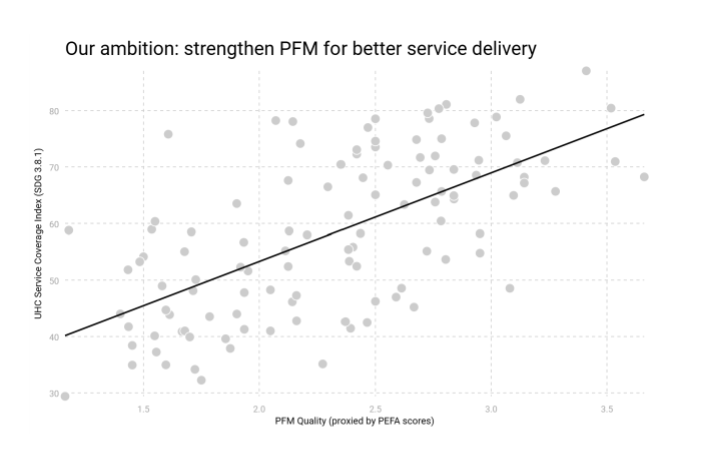Public Finance for Prosperity and Resilience Initiative
Delivering Services through Better Management of Public Finances
Context
We live in a rapidly changing world where resources for service delivery are becoming increasingly scarce, not least due to increased spending pressures, rising cost of capital, and diminishing external aid.
This puts pressure on governments to step up to finance the emerging gap from domestic sources and find efficiency gains where possible. Public institutions and financial management systems need to be fit for purpose to rise to the challenge. Given the current environment, the need for effective institutions and public financial management systems to ensure the efficient delivery of quality services has never been greater.
However, institutions and PFM systems remain often ineffective. For example, despite decades of reform funds still don’t reach the frontlines, leaving schools without textbooks and clinics without necessary drugs and medical supplies. Basic infrastructure is often lacking, and the limited investment is eroding due to inadequate maintenance budgets. Despite the human and economic cost of the Covid-19 pandemic, many PFM systems have still not adapted adequately to emergency needs making countries vulnerable to the next shock.
External aid may be diminished, but its relevance as a facilitator for prosperity and resilience has never been greater. Not to finance the growing delivery gap, but to support the capacities of countries’ own institutions and public finance systems to cover the gap. Only then can aid be leveraged to help deliver on the sustainable development goals.
There are three interconnected global megatrends that necessitate urgent action for effective use of public resources:

Growing expenditure pressures
Just maintaing current levels of basic services is getting increasingly expensive given inflationary pressures, population growth, conflict, and increased climate and economic uncertainty.

External aid is undergoing a period of rapid decline
Countries that were reliant on external aid will need to find a way to finance this emerging gap and set up PFM mechanisms to operationalize effective spending in areas that were previously covered by donors.

Capital is getting increasingly expensive
Access to capital is becoming increasingly unreliable amid volatility in interest rates, and uncertainties about the future of the international financial and trading system thereby increasing borrowing costs and exacerbating debt vulnerabilities.
Purpose
The mission of the Public Finance for Prosperity and Resilience Initiative is to address this need and support countries in building public sector institutions and financial management systems that are effective, accountable, and ultimately equipped to navigate the increasing demands of this rapidly changing world. In other words, support the efficient use of limited resources.

Pillars of Action
This initiative is a collective of experts that work with countries to address these public finance challenges directly, leverage aid in the process, and help build domestic capabilities. It will focus on strengthening institutions and public financial management arrangements in social sectors, including education, health, nutrition, and social protection as well as equipping public finance mechanisms with the necessary tools for emergencies preparedness and response. Within these, support will be provided through a three-pillar structure:
1. Identifying service delivery bottlenecks and building reform momentum
A systematic approach will be applied to identify how institutional and PFM reforms can be strengthened to deliver better results across each sector. This will be based on:
- mapping out context including flow of funds and relevant institutions to areas of focus;
- identifying role of public finance and bottlenecks;
- exploring and understanding key stakeholders in role of public finance and opportunities to drive public finance action;
- co-creating solutions with teams; and
- driving action to unlock the role of public finance. For example, the approach would allow teams to map out the role of public finance in the provision of primary care, identify bottlenecks and craft an actionable response.
2. Developing NextGen PFM capabilities
It is critical to develop and retain capacities to implement PFM reforms is a critical element of the initiative. This includes developing training materials, deploying these in partner countries with sector and finance institutions and building a network of practitioners and partnerships with universities that can deliver on capability building efforts at scale.
management, machine learning and artificial intelligence, blockchain, FinTech solutions in the banking sector, and mobile verification. It will help advise on what type of public finance challenge can be addressed, what technology options are available and may be appropriate, how to make choices and thereby build capacities on how to engage with the technology sector more effectively.
3. Integrating technology solutions
Technology solutions hold enormous potential to support government financial management processes. Pillar 3 of the initiative will help provide guidance on the application of maturing technologies, such as identity management, machine learning and artificial intelligence, blockchain, FinTech solutions in the banking sector, and mobile verification. It will help advise on what type of public finance challenge can be addressed, what technology options are available and may be appropriate, how to make choices and thereby build capacities on how to engage with the technology sector more effectively.
Expectation
Through the three-pillar approach the public finance for prosperity and resilience initiative aims to equip countries with the tools needed to handle the complexities of the modern world and foster agility, responsiveness and accountability. It will allow stakeholders in key service delivery sectors to identify opportunities to operate more effectively, build domestic capacity for reform implementation and leverage technology options to their full potential. Together, this initiative fosters ownership, sustainability, efficiency and accountability – which are essential attributes for managing the public sector in an increasingly complex world
Ownership
Empowering countries to craft domestic service delivery agendas
Efficiency
Facilitating good use of public resources for service delivery results
Accountability
Ensuring accountability for resources and results
Sustainability
Leverage aid and effective domestic institutions for sutainable financing of services
